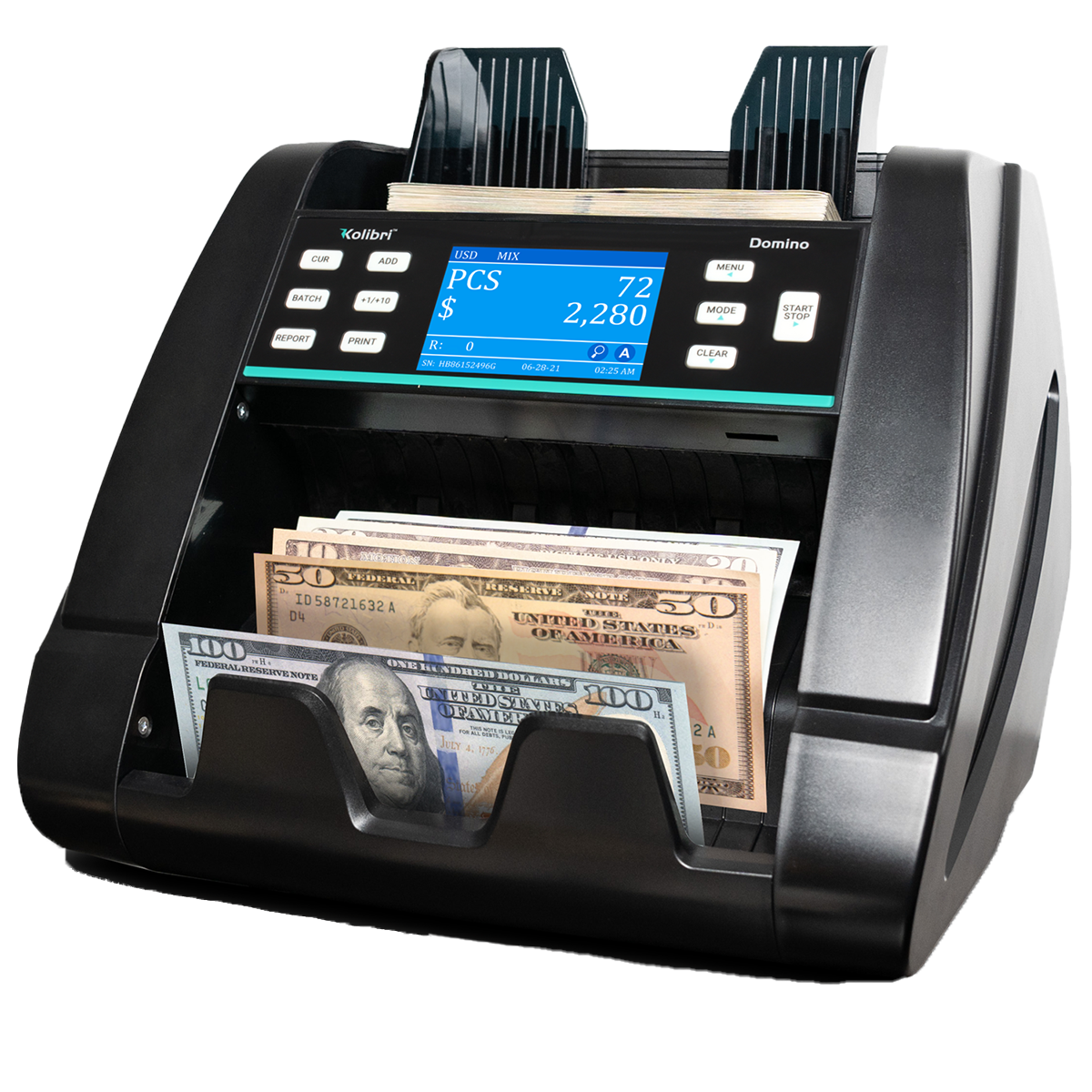Mixed Bill Counters

Mixed Bill Counter
To avoid jams and ensure proper operating speed of the machine, it is important to correctly load the hopper. Bills should be placed in a neat stack prior to being placed into the hopper.
Safety Tip: Keep fingers, hair, and loose clothing away from moving parts.
ATTENTION: The unit should always be turned off and disconnected from its power cord before cleaning. DO NOT use solvents such as thinner, alcohol, etc. to clean the machine.
Most operational problems can be avoided by regular care and preventative maintenance. Taking regular care of the Domino will significantly increase its lifetime.
To avoid problems, make sure there are no metal clips or rubber bands in the bills being counted. Be sure to follow the proper procedure for loading the hopper, refer to section 2.2 Loading The Hopper in the User Manual.
For best results, it is recommended to use an air duster and a soft bristle brush to remove any dust or debris from the interior of the unit. When not using the machine for an extended period, cover it with the dust cover (not included with the unit) to prevent dust from settling inside.
All parts of the Kolibri Domino need daily care and cleaning. Pay close attention to the sensors, which are delicate components. If any dust or other foreign matter adheres to the sensors, it may cause various problems during operation of the machine.
NOTE: The Domino, like all other discriminators on the market with integrated detectors, cannot guarantee a counted bill to be genuine or counterfeit.
There are several reasons a genuine bill may be recognized as counterfeit, or vice versa. Possible reasons include: direct sunlight exposure, worn bills, excessively dirty bills, or highly advanced counterfeiting techniques used to produce the bill. Separate equipment may be required to definitively determine whether a bill is counterfeit.
For all error code references, open the User Manual:
Section 6.4 Troubleshooting.
During transportation or normal wear, the feed mechanism may loosen, causing DOUBLE/CHAIN errors. The feed gap, which controls the bill feed path height, should be set to the thickness of a single bill. A wide gap causes DOUBLE/CHAIN errors, while a tight gap may prevent bills from feeding or tear them.
To adjust the feed gap:
Note: Adjust in small steps, testing after each turn, to avoid overshooting the optimal gap.
The unit's Contact Image Sensors (CIS), Ultraviolet (UV), and Infrared (IR) sensors are factory-calibrated but may lose sensitivity over time, leading to ID errors. To recalibrate, follow these steps:
Sensor Care: Clean sensors daily using the provided brush or dry cloth. For rubber rollers, use a damp cloth with mild soap, ensuring no residue remains.
Kolibri Domino has been developed to count up to 1,200 bills per minute, which makes it one of the fastest top-loading bill counters on the market. Therefore, to avoid jamming, misfeeding, or other errors, it’s extremely important to use the proper bill loading method. For better results, it’s also recommended to not count more than 200 bills at a time.
Kolibri recommends the loading technique as described below:
Avoid counting bills that are wet, excessively dirty, soiled, folded, curled, or with foreign material like clips, bands, etc. Bills such as these can cause the machine to malfunction.
If issues persist despite following these steps, visit Contact Us at Support Center section for further assistance.
During transport or regular use, the feed mechanism’s settings may loosen, causing DOUBLE, CHAIN, or HALF errors. These errors occur when the feed gap, the height of the bill feed path, is not properly set. The feed gap should align closely with the thickness of a single bill.
Feed Gap Adjustment Procedure (Video)
If issues persist despite following these steps, visit Contact Us at Support Center section for further assistance.
To ensure optimal performance and prevent errors such as Double and Half errors, regular maintenance of the Kolibri Domino is essential. Dirty sensors can lead to decreased functionality, so cleaning the unit daily is recommended.
Important Cleaning Guidelines:
Key Areas to Clean:
Back Door Sensors: Use the provided bristle brush or dry cloth.
Inner Sensors: Clean with a dry cloth.
Hopper & Stacker Sensors: Clean frequently with a bristle brush or dry cloth.
2. Rubber Rollers: Clean with a slightly damp cloth, using a small amount of liquid soap if necessary. Ensure soap residue is fully removed.
Kolibri Domino Sensors:
Maintenance Recommendations:
To maintain optimal performance and prevent ID errors, it is recommended to recalibrate the Contact Image Sensors (CIS), Ultraviolet (UV), and Infrared (IR) sensors periodically. Follow the steps below to recalibrate:
Kolibri Domino Calibration Procedure (Video)
By following these steps, you will maintain the unit's calibration and ensure accurate performance.
The Kolibri Domino provides the option to display the report on the screen and print it if external printer is connected (printer not included).
The thermal printer can be bought from the third party company and be connected via printer adapter (comes with the unit) to the unit.
Below please see instructions on how to connect external printer to the Kolibri Domino.
1. Please locate printer adapter that comes with the unit.
2. Please connect the RJ-11 end of the adapter cable to the RJ-11 port at the back of the Domino.
3. Connect one end of the printer cable (comes with printer) to the printer while RS-232 end of the printer cable must be connected to the RS232 end of the adapter cable.
4. After the connection process is successfully done, make sure the Kolibri Domino and the printer are both on. Count the stack of mixed denomination bills, when done, press report button on the display and then print button to print the report displayed on the screen.
5. If you have any issues with the connectivity of the printer, please contact us any time
None of these? Contact Us
Document Downloads: User Manual